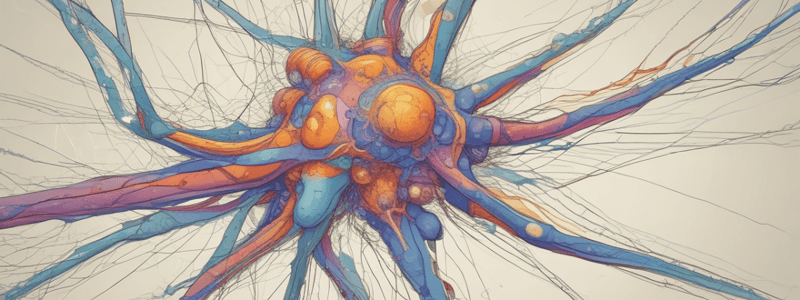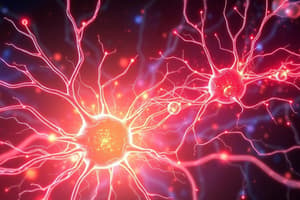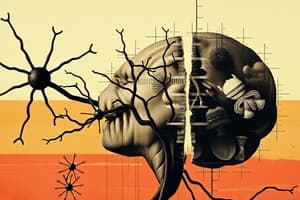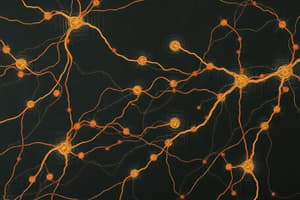Podcast
Questions and Answers
How is information coded in neurones?
How is information coded in neurones?
- In the form of action potentials (correct)
- Through neurotransmitters release
- Via direct cell-to-cell connections
- By the number of dendrites
What is the main function of dendrites in a neurone?
What is the main function of dendrites in a neurone?
- Regulating body temperature
- Receiving information (correct)
- Producing energy
- Transmitting information
Which fluid compartment occupies 66% of total body water?
Which fluid compartment occupies 66% of total body water?
- Extracellular fluid
- Intracellular fluid (correct)
- Blood plasma
- Interstitial fluid
What is the main function of the cell membrane?
What is the main function of the cell membrane?
How do substances with low lipid solubility cross cell membranes?
How do substances with low lipid solubility cross cell membranes?
Where does the separation between intracellular and extracellular fluids occur?
Where does the separation between intracellular and extracellular fluids occur?
What is the major excitatory neurotransmitter that opens Na+ channels in the post-synaptic membrane?
What is the major excitatory neurotransmitter that opens Na+ channels in the post-synaptic membrane?
Which neurotransmitter can be both excitatory and inhibitory in the brain but is mainly excitatory in muscles?
Which neurotransmitter can be both excitatory and inhibitory in the brain but is mainly excitatory in muscles?
What is the main function of GABA, the major inhibitory neurotransmitter?
What is the main function of GABA, the major inhibitory neurotransmitter?
What process involves the addition of multiple EPSPs to reach the threshold for generating an action potential?
What process involves the addition of multiple EPSPs to reach the threshold for generating an action potential?
Which neurotransmitter undergoes reuptake into the presynaptic neurone or is broken down by enzymes?
Which neurotransmitter undergoes reuptake into the presynaptic neurone or is broken down by enzymes?
What is the function of myelin in nerve conduction?
What is the function of myelin in nerve conduction?
What does the Na-K ATPase pump do in terms of Na+ and K+ ions?
What does the Na-K ATPase pump do in terms of Na+ and K+ ions?
Which type of fibre has the highest conduction velocity?
Which type of fibre has the highest conduction velocity?
Why is the membrane most permeable to K+ ions?
Why is the membrane most permeable to K+ ions?
What happens when an action potential reaches the end of an axon?
What happens when an action potential reaches the end of an axon?
What happens to the inside of the cell in terms of charge compared to the outside when equilibrium is reached?
What happens to the inside of the cell in terms of charge compared to the outside when equilibrium is reached?
Which fibre type is responsible for autonomic functions?
Which fibre type is responsible for autonomic functions?
What is the typical range of membrane potential in most cells?
What is the typical range of membrane potential in most cells?
What percentage of myelin is composed of lipid?
What percentage of myelin is composed of lipid?
What is the value of the threshold potential for action potential initiation?
What is the value of the threshold potential for action potential initiation?
In saltatory conduction, the action potential jumps from one __________ to another, increasing the speed of nerve signals.
In saltatory conduction, the action potential jumps from one __________ to another, increasing the speed of nerve signals.
Why do all action potentials produce exactly the same electrical change?
Why do all action potentials produce exactly the same electrical change?
Flashcards are hidden until you start studying
Study Notes
Na-K ATPase Pumps
- Pump 3 Na+ out of the cell and take 2 K+ into the cell for each molecule of ATP, setting up an electrical gradient
- Found in all parts of the body
Electrical Potential Across the Cell Membrane
- The membrane is most permeable to K+ due to leaky K+ channels, allowing K+ to move down the concentration gradient
- The membrane is less permeable to Na+
- The inside of the cell becomes negative with respect to the outside
- Equilibrium is reached when the concentration gradient is balanced by the electrical gradient
- The membrane potential is -50 to -90 mV in most cells
Action Potential
- Depolarisation: a rapid increase in the membrane potential above the threshold potential (-55 mV)
- Repolarisation: a rapid decrease in the membrane potential back to the resting potential (-65 mV)
- All action potentials produce exactly the same electrical change
- A stronger stimulus does not produce a larger action potential
Neurotransmission
- Neurotransmitters are released from the presynaptic neuron and bind to receptors on the post-synaptic membrane
- Glutamate: major excitatory neurotransmitter that opens Na+ channels, causing excitatory postsynaptic potentials (EPSPs)
- GABA: major inhibitory neurotransmitter that opens Cl- channels, causing inhibitory postsynaptic potentials (IPSPs)
- Acetylcholine: can be excitatory or inhibitory in the brain, and excitatory in the muscle
Coding Information
- One EPSP is not enough to produce an action potential; a bigger stimulus is needed
- Summation: temporal and spatial summation of EPSPs can lead to an action potential
The Neurone
- The basic structural unit of the nervous system
- Each neuron is an individual cell that communicates at synapses
- Consists of a single cell body with dendrites (receive information) and axons (transmit information)
- Branch to communicate with many cells
- Information is coded in the form of action potentials
Body Water and the Cell Membrane
- Body water occupies two "compartments": intracellular fluid (ICF, 66% of total body water) and extracellular fluid (ECF, 33% of total body water)
- The ICF and ECF are separated by the cell membrane
- Cell membrane structure: phospholipid bilayer with phosphate heads (hydrophilic) on the surfaces and lipid tails (hydrophobic) centrally
- Protein molecules are inserted into the bilayer
Myelinated Axons
- Myelin: increases the speed of nerve conduction by insulating axons
- Present around nerves in the central nervous system (CNS) and peripheral nervous system (PNS)
- Composed of about 80% lipid
Fibre Types
- A-a: 13-22 µm diameter, 70-120 m/s conduction velocity, motor neurons
- A-b: 8-13 µm diameter, 40-70 m/s conduction velocity, touch, movement
- A-g: 4-8 µm diameter, 15-40 m/s conduction velocity, touch, pressure
- A-d: 1-4 µm diameter, 5-15 m/s conduction velocity, pain, pressure, temperature
- B: 1-3 µm diameter, 2-14 m/s conduction velocity, autonomic
- C: 0.1-1 µm diameter, 0.2-2 m/s conduction velocity, pain, touch, pressure, temperature
Studying That Suits You
Use AI to generate personalized quizzes and flashcards to suit your learning preferences.




